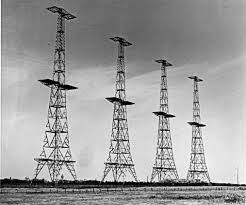1944 / 1945 – a soldier’s perspective – D.H. Reed
On the ground, war is different – as the British and US armies push on into Germany towards the Russians.
Historical Note: “Special Forces” including Glider and Parachute regiments of the British Army and Royal Marine Commandos of the Royal Navy were highly specialized trained troops often held back and used for specific missions; as a powerful vanguard in offensive actions or as a final reserve when situations became desperate. This meant that, by the very nature of war, they were regularly put on emergency standby only to be abruptly stood down to await the next call to action. 6th Airborne Division were the very first Allied troops to land in Normandy and liberate French soil in June 1944.
1944 – “The Beginning and the End”

D-Day Normandy – 6th Airborne Division glider troops
In his own words………….
Returning to UK from Normandy in September 1944, after 3 months of hard fighting from D-Day, the “stickies” (Royal Ulster Rifles – 6th Airborne Division), looked at the empty beds in the barracks and decided that there was time to get them filled before Spring which, by general concensus, was when the next push into Germany might begin.
However, no account had been made of Von Rundstedt, and so it was that on 20th December we received 36 hours notice to “get to the coast and over to the Ardennes!”
Regimental numbers had been made up quickly since the losses in Northern France, including no less than 25 “new” officers who arrived just one afternoon. We were already Yorkshiremen within an Irish Regiment, but now more cosmopolitan than ever with every part of Britain represented plus, France, Netherlands and several Canadians.
Best suits and other “luxuries” were hurriedly put into store and arms an ammunition plus the 101 things we needed for survival were re-packed before a mad dash to the coast.
Driving endlessly, Christmas Day was a non-event without any food at all until reaching Dinant in the early evening where some tea was drummed up and we had a ringside seat as a Messerschmitt 109 fighter made its last spectacular bomb run of the day against the bridge that we were here to defend.
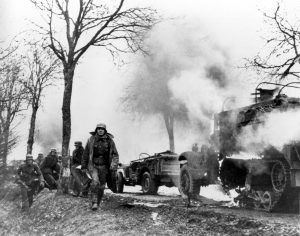
Advancing German troops pass burnt out U.S. Army vehicles – December 1944
The Battle of the Bulge (as it was later known) came and went as the German advance ground to a halt and ran out of fuel, but it had been a cruel time of sub zero temperatures, metre high snow drifts, mine fields hidden by frozen ice, road blocks, Teller mines and frost-bite.
(Note: DHR suffered mild frostbite to his toes whilst the Division held their lines in snow filled trenches for several days – they affected him for the rest of his life).
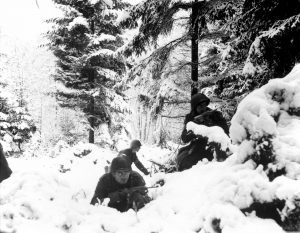
Heavy snow and intense freezing conditions add to the presures on fighting in the Ardennes
Unlike the U.S. troops who recoiled under the intense pressure of the initial German attacks and sadly suffered huge losses especially in troops taken prisoner, we had few casualties fortunately and had held the line during some very difficult days, but the Front was gradually reformed even though enemy activity still kept us busy.
It was about this time that I suffered an infection in a tooth which made my face swell up. The C.O. said I should attempt to get to the Division Medical Unit which was about 12km away. The road was typical of those in Belgium and the Netherlands with a narrow tarmaced road on the top of a large grassed ridge bordered either side by forest. I set off alone in my Jeep and on a long stretch of the raised road I was suddenly aware of shells exploding and two German tanks nosed out of the trees and tried to hit me like shooting ducks in a fairground. Instinctively I drove off the road onto the opposite side of the bank and drove at a precarious angle as fast as I could.
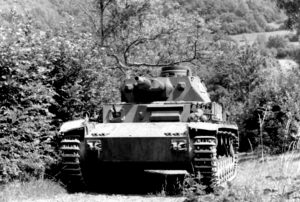
Wehrmacht Panzer Mk.IV tank
The area was clearly still in enemy hands and so I drove into a farm off the beaten track, near the village of Zottegeb. The family were Belgian and immediately took me in and hid my Jeep whilst I attempted to radio my unit. Eventually I heard that RAF Typhoons had straffed the area where the tanks had emerged and after a couple of days I thanked the farmer, his wife and 3 daughters and proceeded with my appointment at the dentist. On my return I still drove on the opposite bank, just in case. (He kept in touch with one of the daughters – Angele – long after the War)
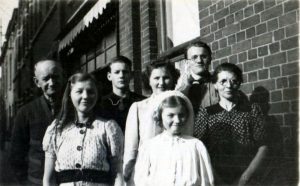
The Belgian family, Mr & Mrs de Sutter van der Stock and their children , who hid DHR, at great personal risk, whilst the Germans searched for him. (picture taken 1950’s)
After that my experiences of the Battle of the Bulge ended. There had been a lack of sufficient warm food, but remarkably less grumbling, yet it was with some pleasure that the “Red Devils” drove back to the UK, our warm barracks and waiting beds, until March.
Operation Varsity – Crossing of the Rhine – 23rd March 1945
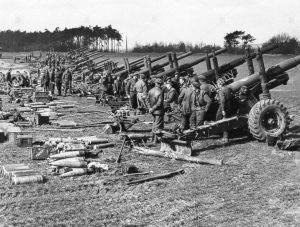
A barrage by over 1,300 guns including these Royal Artillery 5.5″ howitzers begin the operation to cross the Rhine into Germany – 23rd March 1945.
On 23rd March 1945, 21st British Army Group under Field Marshal B.L. Montgomery undertook the largest ever invasion in history with the “Crossing of the Rhine” into Germany. Over a million allied troops took part in “Operation Plunder” the crossing of the River Rhine at Wesel and “Operation Varsity” the airborne invasion with 14,000 paratroopers and 1300 gliders dropped behind enemy lines. (6th Airborne Division lost 347 officers & men killed and about 700 wounded).

Massed parachute drop by Allied Airborne troops – March 1944

6th Airborne Glider Troops – Operation Varsity – March 1945
Both operations were a complete success, and was a great show of strength, spectacular to say the least, and side by side once again with our American buddies the 101st “Screaming Eagles” and the 82nd “All American” both of the XVIII U.S. Airborne Corps under whose direct command we all came.
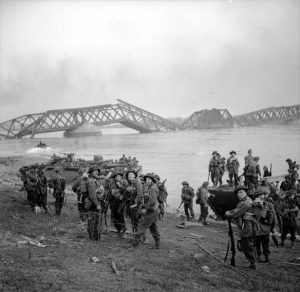
Wesel – 1st Battalion Cheshire Regt cross the Rhine on 23rd March following up an audacious crossing by Royal Marine Commandos the previous night.
The crossing, accomplished one way or the other, we then began edging northwards. Against constant opposition we expected to reach Berlin ‘ere long. (Following the crossing, 6th Airborne was to head north-east towards the River Elbe as part of the British 2nd Army).
Having crossed the Dortmund-Emms Canal in early April we had some stiff resistance to surmount at a town called Lengerich in Westphalia, 15 km south west of Osnabrück. Lengerich was a NAZI stronghold being defended by officer students from Hanover. We overcame this obstacle and went on to Osnabrück and the liberation of some 3000 French, Russian, Polish, Yugoslav and Greek prisoners from Stalag XI.
At Teyandorf there was more opposition which seemed to mark the ending of what had been referred to as our great “Swan”!
Our new instructions were to head north-east towards the Baltic Coast which was easier said than done. We set off toward the River Elbe but came into more “opposition”, and having overcome this the Allied drive towards Berlin was halted to allow the Russians to occupy their agreed territories.
The “Great Collapse” had started and, whilst there were still pockets of resistance here and there, there was chaos on the small roads as the German armed forces plodded endlessly in the opposite direction to ourselves. There were so many troops and vehicles to be moved that the roads couldn’t cope and so Allied units were allocated days when they could move. Part of my unit located a railway train with open wagons. It didn’t take long to find an ex train driver and ex fireman amongst their chaps and so this unit of Special Forces made their own advance by train.
My Regiment became stationary, yet we had been told to advance towards Nenndorf, west of Hanover, then on towards Wismar and the Baltic coast as soon as possible. So, my Second in Command (Major Huw Wheldon – later, Director of the BBC, fame), his batman and I set off in my jeep with two trailers of equipment to see what progress we could make in order to establish strategic positions for the general advance towards the River Elbe.
This particular day had been allocated to a Canadian armoured column and others, so we hid our identities by turning our Airborne red berets inside out to show them as black like the Canadians. (a practice we did on previous occasions to maintain secrecy that special forces were in the area). We covered the Divisional signs on the Jeep and slipped into the Canadian column, managing to leapfrog ahead and making good progress over a long distance. Fairly happily we tucked in behind a tall Staghound Armoured Car making slow but sure progress.
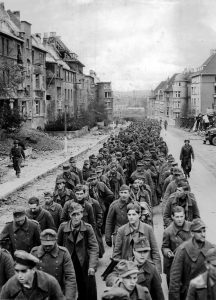
German prisoners of war near Aachen – 1945
German military of all sorts, Army, Navy, Luftwaffe, Todt Workers packed the roads walking slowly in the left hand lane, but fairly happily, and there were smiles and even hand waves as we passed by on the right travelling in the opposite direction. And all around was a cacophony of sounds; of vehicle engines, aircraft overhead, radios crackling and hundreds of voices of all sorts. Suddenly this was all interrupted by gunfire from our right. We were passing through a village and “someone” had objected to us.

Staghound armoured car leading an Allied column past German PoW’s
Shots passed across the front of our Jeep and into the Germans walking past, hitting two of them. Everyone stopped. The crew of the armoured car in front of us were all inside and hadn’t heard the shots so I nipped around and banged on the hull, telling the driver what the problem was, whereupon the gunner attended to the area from where the shots had come from with a liberal application of .5” gunfire which seemed to do the trick.
These I think were the very last shots, fired in anger, that I heard in World War II and would, I assume, be the last that the Canadian armoured car gunner would hear too?
This temporary stop had given us a time to look around and I noticed three SS officers, in their best uniforms, mixed up with their walking countrymen but occupying a VW Schwimmenwagen (German jeep sized amphibious vehicle). So, a quick decision. Relieve them of their vehicle, put one of my trailers behind it – the Major could drive my Jeep and I, the Schwimmenwagen – and we would be able to make better progress.
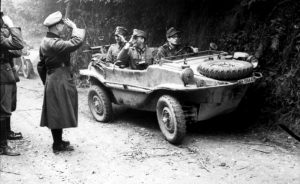
Volkswagen Schwimmenwagen amphibious vehicle – 1945
The three SS men showed no emotion on being relieved of their vehicle, one of them even saluted me and offered to show me the controls – very polite they were – but the surprise, a few seconds later was the cheers I got from the German troops as I pulled the vehicle out of their column and turned it around. The three SS officers were quickly found places in the walking ranks of their countrymen.
A submariner, conspicuous in his Navy uniform amongst the dull grey uniforms threw his hat into the air with delight as the column started its slow plod to the safety of the POW cages, and it seemed very obvious that the ordinary serviceman didn’t have any love for the SS. There were lots of animated conversation, and I think I helped make their day!
Eventually reaching our designated area and the amphibian was dumped temporarily whilst we made a reconnaissance of the area in the Jeep. The Major and his batman went into some buildings in what I would call a “street village” and from the top of a wall I spotted some faces looking at me. One said, “Hi you guys, there’s a Limey here in a real American Jeep”! Two or three faces soon became twenty or thirty as more U.S. soldiers climbed over the wall and jumped down to greet me. All seemed to be smoking and they said they had been prisoners inside this old mill since early 1944 and had never been given their Red Cross parcels. However the prison staff had heard that the Allies were on their way and had abandoned their charges just before our arrival. The Americans had located the room where the Red Cross parcels were stored – unopened. Very quickly the floor of my Jeep was covered by packets of Lucky Strikes, Camel and Chesterfield cigarettes as well as Lifesavers (those sweets with the hole in the middle) . They, as well as me, hadn’t seen so many “goodies” for so many years.
It was here that I met Eugene Szymansky, a U.S. Infantryman from Pittsburg, Pennsylvania, whose address I took and sent home to my Mother, who quickly wrote to Eugene’s mum to tell her that her son was “OK”! This was quicker than official channels. His mother and younger sister lived in a high rise block and I learned several years later that the mail was delivered to a single office on the ground floor to be collected by the occupants each day.
Eugene had not been heard of for over a year “missing in action” and Eugene’s sister, seeing the English stamp on the envelope, although addressed to her Mum, opened the letter to read the good news. Instead of taking the elevator back to the apartment she walked up the stairs hammering on every door to people she didn’t even know, and shouting; “Eugene is alive!!”
Hitler celebrated my 23rd birthday on April 23rd by ordering the arrest of Hermann Göring, who had “tried to be helpful” by suggesting that if Hitler was having a hard time in Berlin, then he would be pleased to take over his job. Hitler didn’t seem to take kindly to this suggestion?
On the morning of 29th April, British Commandos crossed the River Elbe followed the next day by us, taking Wismar on the Baltic Coast on 2nd May just hours before the Russians arrived, thus depriving the Soviets of being able to drive into Denmark.
Hitler committed suicide on 30th April and this was announced to everyone on the wireless. A small crowd of German civilians were around my Jeep hoping to glean some news and I was to break the news to them that “Hitler ist tot”. The women began to cry, which I found a little surprising, as most that I had met previously, and especially the military personnel in those latter days, were fed up with war for which they all blamed Hitler.
My unit eventually reached its final position and we rested up for a week or two. Here in the middle of nowhere I was to meet with the Russians in an isolated farmhouse where they were eating cubes of raw cold fish and chocolate toffees. They pointed their machine guns at us as we approached their position and followed our every move whilst our Major stood on the seat and waved a handkerchief shouting “Englanders”, as we realised that they had probably never seen a British serviceman before and were certainly a bit “trigger happy” anyway. They eventually tried to feed us – not too successfully though – and we shared a drink with them. A Russian Officer pulled a brass button with the communist hammer and sickle, off his shirt and gave it to me, which I still have to this day.
British 6th Airborne troops meet Soviet Army troops across the River Elbe – 2nd May 1945.
One thing that struck me was the standard of their equipment. They had ancient lorries of WW1 vintage with solid tyres and the general equipment (the little they had) was of very poor quality. To have come so far with what they had, against the advanced technologically of the Wehrmacht, struck us as quite remarkable. This then was as far as we could go across Germany.
Whilst there, about 100 or so ex prisoners of war suddenly arrived on foot. All Royal Air Force and trying to navigate their way into our lines with the aid of a German school atlas. As they came down the farm track, towards the Russian unit, having walked from Stalagluft 1 Camp, I was able to turn them around and set them on the right road as they were heading straight into the Russian Lines.
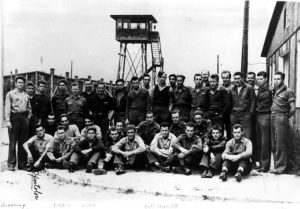
Stalagluft 1, Barth, Pomerania – Around 9,000 airmen including 7,588 U.S.A.A.F., 1,351 R.A.F. & R.C.A.F. were imprisoned here when it was liberated on the night of 30th April 1945 by Russian troops
So, the war in Europe came to an end with V.E. Day on 8th May. By the 11th it was about all over. Since the Crossing of the Rhine we had advanced over 400 miles (644 km) by road, field and ditch.
Most of my unit flew back home, but we had another job to do before we could be in our own beds again. Eventually I hitched a lift back to U.K. courtesy of the US Navy on a huge tank-landing craft. “Hey buddy there are some empty bunks on “A” deck if you want some shut-eye?”. Little chance really as the ship’s P.A. system was blasting out Glen Miller’s “Moonlight Serenade” occasionally interrupted by “Now hear this……..”.
Eugene got back to the States and married his Eleanor. We write once a year as we’ve done so for 60 years and I sometime look at the scrap of paper headed with the words “Neptunwerft G.m.b.H, Rostock”, on which he wrote his home address when we met all those years ago.
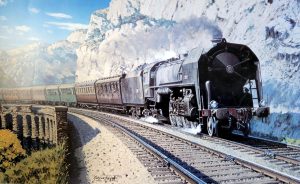
Taking the Medlock Train home at the end of hostilities. This is the train used to transport British and Allied Troops back home to Britain. It was pulled by a SNCF (French Railways) coal-fired, Class 141 R steam locomotive. 1000 of these were built in Canada and USA to replace those taken by the Germans or destroyed in Allied bombing. There were 3 routes in 1945: Route A – Toulon to Dieppe/Calais; Route B – From Milan via Switzerland to to Calais; Route C – from Villach (south Austria) to Calais / Hook of Holland.
DHR May 1946.
On arrival back in Britain his unit was equipped with dark green clothing kit ready for embarkation to the Far East / Pacific theatre against the Japanese, but before leaving the two atomic bombs were dropped and Japan surrendered. The RUR were thus diverted to Palestine, Syria and Lebanon where they supported policing duties for a year. Afterwards they again were posted back to Britain and Desmond had the sad job of saying goodbye to his beloved Jeep in Palestine. He had driven right across Northern Europe in the British advance to Germany. He eventually returned to UK on the famous Medloc Troop Train, and like many soldiers he was eventually de-mobilized from regular service and “returned to square one” by re-joining his original Territorial Army Regiment – the Green Howards as Warrant Officer II.
D.H. “Digger” Reed, 1st Battalion R.U.R., 6th Airborne Division.

D.H. Reed in his faithful Jeep, which he drove “often under fire” in the Allied advance from the River Rhine to the River Elbe during the liberation of northern Europe.
Early Career
An aviation enthusiast all his life Desmond Reed joined the British Army in April 1939 because there was no RAF recruiting office in the area of the North Riding of Yorkshire where he lived. Upon reaching his 17th birthday he applied to join the Territorial regiment, the Princess of Wales’s Own Yorkshire Regiment, “Green Howards”, his first posting was to help guard the ultra secret “Chain Home” Defence Radar Station at Staxton Wold overlooking the North Sea on the East Coast of England near Scarborough. As he states, “the nearest to this mysterious equipment I ever reached was having to climb up to the 240 ft (73m) platform on guard duties during that cold pre-Christmas period of 1939, to keep an open eye out for “subversive elements” – generally speaking the I.R.A.
Home Chain Defence Radar towers 1940.
By the start of 1940 his regiment was, he continues, “part of that mad dash for the Continent, but those of us under 17 and three-quarters were considered too young for overseas duties and were transferred to the Royal Artillery – Anti-Aircraft Gunners. What a different sort of Army! Bearing in mind that this was the first time most of us had “left our mother’s apron strings” life was hard enough, so the change to the Royal Artillery where, on this occasion we actually slept in warm billets and ate “proper” food was a most welcome change. Here we had huge searchlights, arc lamps, telephone equipment, petrol/electric generating vehicles, diesel generators, listening equipment etc, which to me as a reader of “Modern Boys Weekly” was a wonderment”.
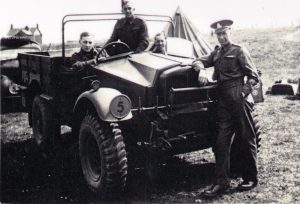
DH Reed (in drivers seat of Morris Commercial 15cwt truck) 1940 – Royal Artillery Anti Aircraft Defence – probably Barrow in Furness, Cumbria. .

A battery of 4.5″ Royal Artillery anti aircraft guns – 1943
After Dunkirk the defence of aerial Britain was given first priority as the Battle of Britain began and Desmond specialized in radio communications and electricity generation for anti-aircraft (Ack-Ack) batteries around Britain. Initially in Gosport, Hampshire and then Liverpool & Manchester in Lancashire, Barrow in Furness in Cumbria and back to the south of England and Devon. As the air war over Britain came towards its end in 1943, Desmond transferred to a regiment in the new special forces units being established for airborne operations using parachutes and gliders, the “Red Devils”, and the “Successful 6th” Airborne Division.
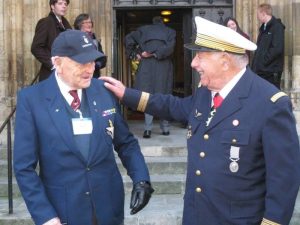
D.H. Reed with Col Louis Hervelin (see: https://afheritage.org/the-battle-of-britain-80th-anniversary), at York Minster 20th October 2011.
to be continued……………

